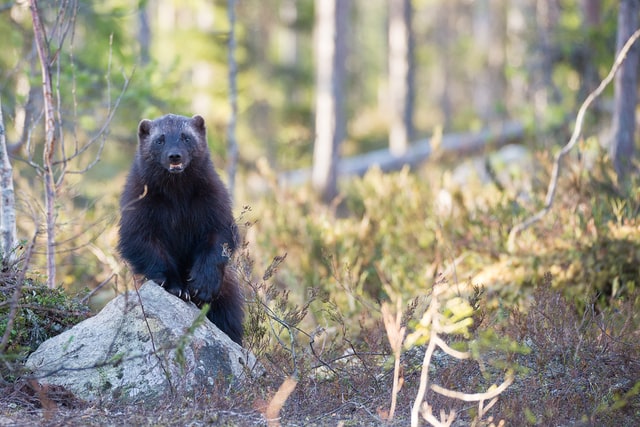Man-wildlife conflict in Kashmir refers to the conflicts that occur between human populations and wild animals in the region of Kashmir, which is located in the northernmost region of India and Pakistan. This conflict can take many forms, such as crop damage caused by wild animals, human injuries or deaths caused by wild animals, and loss of livestock. Some of the most common wild animals that are known to cause conflict in Kashmir to include leopards and bears.
Man-wildlife conflict in Kashmir has been on the rise in recent years, with an increasing number of cases being reported. Some of the reasons for this increase include habitat loss, food scarcity, and the expansion of human settlements into areas where wild animals live and all are anthropogenic factors.
Shot somewhere in Kashmir.
— RJ Nasir (@rjnasirkashmir) June 24, 2019
Boys taking a walk with leopard.
The man animal conflict has increased over the years as we have started to ventur into places meant for wildlife . @aiburza @mashah06 @sairmir @sahranmalik pic.twitter.com/YcY2gdwosQ
Over the years, agriculture, horticulture, and urbanization have encroached upon the habitats of wild animals, forcing them to move closer to human settlements in search of food and shelter. This leads to conflicts with local people, particularly farmers and herders, who may suffer damage to their crops and loss of livestock.
Wildlife conflict in Kashmir during the winter months can be particularly severe due to the harsh winter conditions and limited food availability for wild animals. The snowfall in the region makes it difficult for wild animals to find food, and they may wander into human settlements in search of food, leading to conflicts with people. This can include damage to crops, loss of livestock, and even human injuries or deaths caused by wild animals. In addition, the snowfall also makes it difficult for humans to access their fields and orchards, leading to further economic losses for the community.
🎥 Here is a snippet from our new documentary: Fragmented landscapes and fearful children: human-wildlife conflict in Kashmir
— The Third Pole (@third_pole) October 17, 2022
👏 Thank you to @AaqibFayaz19, Danish Qazi, and @kashifshakeel_ for your hard work on this piece.
🔎 Click the link to watch:https://t.co/sdI2sAq3Ei pic.twitter.com/aqufUjDHd8
There are several ways to help wildlife during the winter months:
Provide food: One of the most important ways to help wildlife during the winter is to provide them with food. This can be done by putting out bird feeders, leaving out seeds, berries, and nuts, or even creating a small wildlife garden in your backyard.
Provide shelter: Wildlife also needs shelter to survive the winter. You can help by building or providing nesting boxes, brush piles, and other forms of shelter for animals to use.
Keep water available: Wildlife also needs access to fresh water, especially in the winter when natural sources may be frozen over. Keep a heated bird bath or a shallow dish of water available for animals to drink from.
Avoid using pesticides and herbicides: These chemicals can be harmful to wildlife, especially during the winter when food and shelter are scarce.
Support conservation efforts: Supporting conservation organizations and their work to protect wildlife habitats, corridors and corridors can help ensure that wild animals have the resources they need to survive the winter.
It is essential to remember that wildlife should not be fed or sheltered excessively as it can disrupt the natural balance of the ecosystem and the animals lose their natural survival skills.
The wildlife in Jammu and Kashmir is declining as compared to their previous populations and authorities and people need to adopt all the measures that can help the wildlife of Jammu and Kashmir.
There are several ways to reduce man-wildlife conflict in Kashmir:
Habitat protection and restoration: One of the main causes of man-wildlife conflict in Kashmir is habitat loss. By protecting and restoring natural habitats, wild animals will have less reason to come into contact with humans, reducing the likelihood of conflict.
Community-based conservation: Involving local communities in conservation efforts can help to reduce man-wildlife conflict by educating them about the importance of wildlife and how to coexist with it. Community-based conservation programs can also involve compensating farmers for crop damage caused by wild animals.
Wildlife corridors: Creating wildlife corridors can help to connect fragmented habitats, allowing wild animals to move between different areas without coming into contact with human settlements.
Non-lethal management techniques: Instead of using lethal methods to manage wild animals, non-lethal techniques such as habitat manipulation, repellents, and translocation can be used to discourage wild animals from entering human settlements.
Public awareness: Raising public awareness about the causes and consequences of man-wildlife conflict can help to reduce negative attitudes towards wildlife and promote more tolerant and coexistence-oriented behaviors.
Professional management: Professional wildlife managers can help to reduce man-wildlife conflict by developing and implementing conservation and management strategies that are tailored to the specific needs of the local community and the wildlife species involved.
Lastly, encourage sustainable land use practices: Encouraging sustainable land use practices such as agroforestry and permaculture can help to reduce human-wildlife conflict by providing wild animals with alternative sources of food and shelter.
